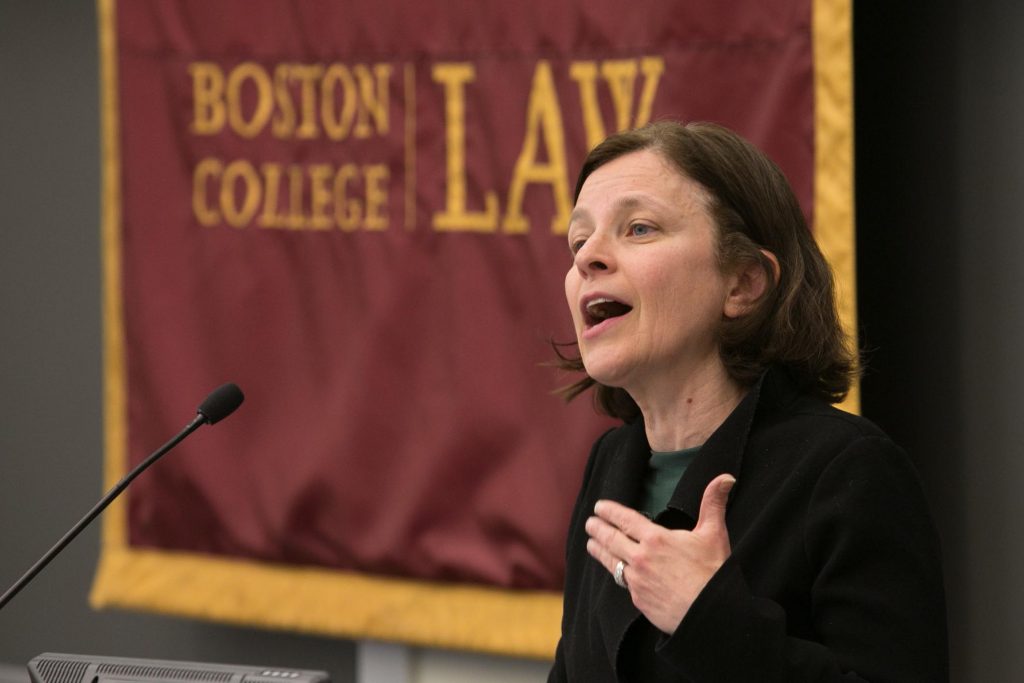The plight of students laboring under tens of thousands of dollars of student loans, as well as possible solutions to the untenable system, was on the minds of panelists, attendees, and the keynote speaker of the March 18 Rappaport Center conference “Student Debt Crisis: Issues and Solutions.”
“This is a critical challenge that affects every part of our economy, and goes to the core of who we are as a nation,” said Deputy Secretary of the US Department of the Treasury Sarah Raskin (pictured above) in her keynote address. “But today, for too many Americans these quality institutions feel out of reach. As tuition has increased, the ability to afford a high quality education has decreased.”
Raskin outlined the grave issues facing students, and the entire edifice of student financing. “With tuition growing at rates far in excess of average earnings, particularly in the wake of the great recession, the challenge of maintaining an affordable, accessible system of high quality higher education has markedly increased.” she said.
So has the speed of debt-taking. “Americans owe more than $1.2 trillion in federal student loans today, up from just over half a trillion at the end of 2007,” she explained. “Though it does not rival mortgage debt, the total outstanding student loan debt is now larger than either credit card or auto loan debt. Seven out of every 10 college graduates take on debt to finance their higher education.”
Though the system supports broad access for millions of students who later find it within their ability to make payments and manage their debt, Raskin expressed alarm that “approximately 11.6 percent of the balances of federal student loans that have entered repayment are in default, and in the direct loan portfolio, another 5.5 percent are at least 91 days delinquent.” These statistics do not “reflect a student loan financing system that is fully meeting its mandate to advance the public good,” which higher education offers.
In conclusion, she suggested that both public and private players need to “better align enforcement and metrics for accountability with the goals of our student loan financing system,” to improve accessibility, transparency, and affordability.”
The conference panelists dug deeper into some of these challenges. One explored whether the privatization of the student loan marketing corporation, Sallie Mae, fulfills the organization’s mission to provide better loans at lower interest. The conclusion was decidedly mixed. While privatization under the Clinton Administration did lead to wider access to student loans, it also led to “much more confusion regarding the source of the loans,” said Stephen Burd, senior policy analyst at the New America Foundation. “Where students thought they were taking federal loans because they came from Sallie Mae, they were actually taking private loans, and perhaps the confusion caused them to take out loans that they maybe shouldn’t have.”
Other panels addressed the need for reform in servicing student debt, especially the dynamic between the government-authorizing of loans and the private organizations that service and collect these loans.
Rohit Chopra, senior advisor at the US Department of Education explored the vital role of financial markets and financial services in student debt availability and affordability. “Capital markets play a role in shaping outcomes for students and borrowers,” he said, “and government regulations and reforms must be mindful to not make a complicated process even more confusing. Transparency is key.”
The panelists concluded that financial services available to students must be made more streamlined and open. They also supported a federal policy of debt forgiveness that would empower students to pay their debt down faster and contribute more effectively to the economy and society as a whole.


